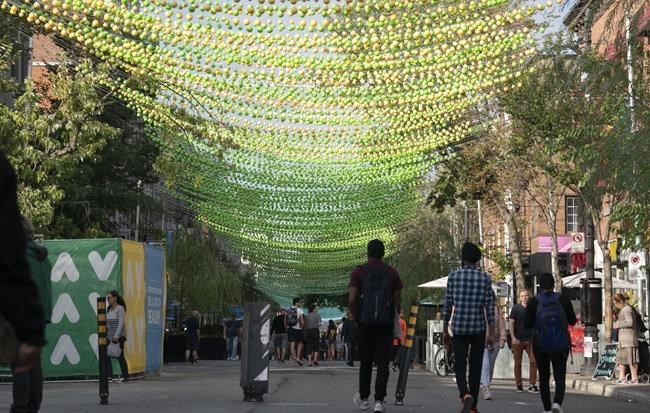MONTREAL — Members of Montreal's Village community say they've seen some improvements to local security and cleanliness in the 10 months since the city launched a revitalization strategy, but they argue homelessness, drug use and mental health problems will persist unless Quebec commits more resources.
Tensions in the Village peaked last summer when several business owners decided to close their outdoor seating areas, citing crime, incivility and unsanitary conditions on the neighbourhood's commercial heart of Ste-Catherine Street.
Yamato Dumpling owner Emily Yu says the situation became so acute that she installed a doorbell to control entry to her restaurant. But more recently, she says customers have noted positive changes in the local climate.
"Those are improvements we have really seen," she said inside Yamato Dumpling on Friday. Yet there still hasn't been enough progress to make her confident enough to reopen outdoor dining this summer, she said.
"It's really hard," she said. "We have the policies, everything is clear, like (it's) above the sea level, but you never know what is behind the sea level."
Among the measures in Montreal's strategy to improve the Village were greater investments in security and community activities in the neighbourhood's public squares, as well as a public awareness campaign to promote cleanliness. In addition, the city deployed mediators, a sexual violence prevention team and specialists in intercultural relations to work with vulnerable people. Police also increased their presence in the area.
"We saw a clear difference quite quickly," Christian Généreux, a spokesperson for advocacy group J'aime mon Village, said of the effect of those measures. He contends, however, that municipal jurisdiction is limiting local officials' ability to address the health and social challenges that underlie the Village's troubles.
"The city is somewhat restricted in its actions," Généreux said. "What they can do at borough and city level, I think they are doing what has to be done to help the situation."
He's calling on Quebec to develop a more comprehensive effort by leveraging its authority over health, social services and housing.
François Bergeron, director of local community service association Corporation de développement communautaire du Centre-Sud, says he expects challenges related to homelessness to once again envelop the neighbourhood in the warmer months in the absence of greater engagement by the provincial government.
"I'd say there's work being done on the effects, but there's no real work being done on the root causes, access to housing, access to health services," he said. "In this context, it's a bit cheerful to say that this summer it's going to be more beautiful, cleaner, more pleasant. I find it hard to be optimistic about this."
In an emailed statement, a spokesperson for Lionel Carmant, Quebec's minister responsible for social services, said his office is "sensitive" to the situation in the Village and committed to meeting the area's needs.
The statement also pointed to recent supportive housing projects for people experiencing homelessness, as well as a $75 million investment by the provincial government to combat homelessness in Montreal and create hundreds of emergency shelter spaces. The Montreal branch of the Quebec health network offers further assistance through dedicated teams that meet with unhoused people and people in crisis, in addition to its ongoing support for several community organizations, the spokesperson said.
Généreux described the provincial government's approach as piecemeal and scattered.
"The problems are very complex," he said. "And it involves so many ministries that all of them need to work together to find a global solution and stop working in silos."
For now, the core of the village on Ste-Catherine Street is in a state of "flux," said Tanner Tallon, a member of a local resident association convened by the city to serve as a forum for citizen engagement.
"The village is not going to be what it was five years ago. It's not going to be what it was 10 years ago. It's a question of what it's going to be next year and in five years," he said. "There's no rose-coloured glasses. Communities just like their citizens are ever changing and ever growing."
This report by The Canadian Press was first published April 20, 2024.
Thomas MacDonald, The Canadian Press

